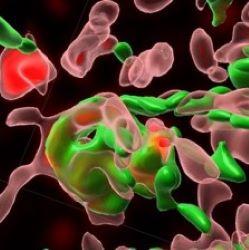
Conserved from yeast to humans, autophagy is a pathway whereby cells engulf cytoplasmic contents in double-membraned autophagosomes, which traffic their contents to lysosomes for degradation. This process is vital for cellular homeostasis, and impacts diverse diseases including neurodegenerative conditions. Autophagosomes evolve from precursors called phagophores, which have been inferred to derive from spherical structures with a single hole that is eventually closed. However, using advanced 3D super resolution SIM2 microscopy at CIMR's dedicated Facility managed by co-author Matthew Gratian, Dr Claudia Puri from the Rubinsztein lab has revealed autophagosome precursors originating from recycling endosomes with unexpectedly more complex structures. Dr Puri and colleagues' new paper published in Developmental Cell shows that phagophores often derive from multifocal origins on recycling endosomes and have finger-like morphologies with multiple openings that close while becoming more spherical. These tentacle-like features may enable the cell to more easily engulf material and organelles destined for degradation.

